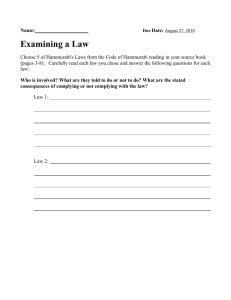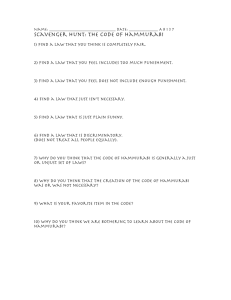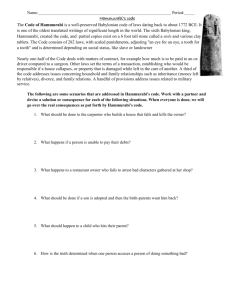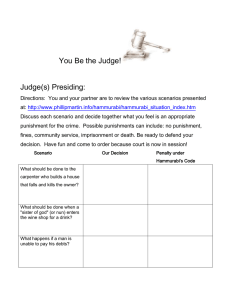Life in the Fertile Crescent
advertisement
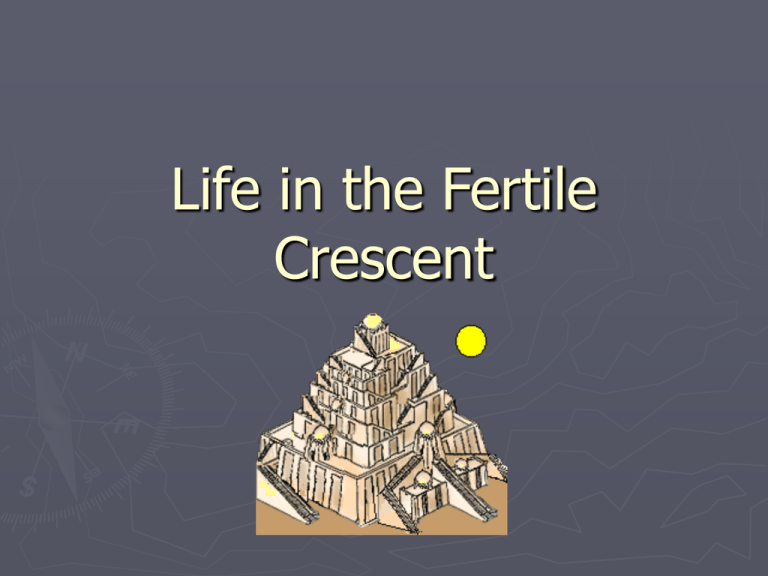
Life in the Fertile Crescent The Fertile Crescent was a quarter moon shaped area extending from the eastern banks of Mediterranean Sea and curving north to the Persian Gulf. The rich land between the Tigris and Euphrates Rivers supported many farming villages. In the region called Mesopotamia “ the land between two rivers” several villages grew into cities. Mesopotamia’s earliest cities rose up in an area called Sumer. People lived and worked together and formed a complex society or civilization. A civilization is a culture with well developed forms of government, religion, and a written language. The people of Sumer built dikes and dug canals to hold back the flood waters from the Tigris and Euphrates Rivers. Life in the cities posed new problems for the Sumerians, and they had to find creative ways to solve them. These people used technology. (the use of tools and skills) to build their cities. One technological advancement made by the Sumerians was the invention of the wheel. Wheel technology made other inventions possible, including the wheeled cart. They used domesticated oxen and donkeys to pull heavy loads using the wheeled carts. Wheeled carts were important in moving construction materials. They were able to build seven-story temples called ziggurats. This is where they worshiped their gods. The Sumerians believed that each city had a god to watch over and protect them. They also believed that the gods controlled the winds and the rain, the sun and every part of nature important to agricultural society. The Sumerians believed that large harvests were a sign that the gods were pleased with them. They also thought that floods and other natural disasters were signs that the gods were very angry with them. When large numbers of people live and work together, laws are needed to keep order. In large societies this can be achieved through a system of government. A government is an organized system that groups use to make laws and decisions. Sumerian farms produced a surplus or extra supply of food. This meant they had enough to barter or trade for things they needed. Not everyone in Sumer, including the kings could read or write. Those who could write were called scribes. Often they kept records, wrote letters for other people. They also copied down stories and songs. The needs of a large complex society led to new ways of doing things, or innovations. Acre (unit of measuring land) Cargo ships with sails for trading Quart to measure wheat and barely Cuneiforms (writing system of wedge shaped symbols) The people of Phoenicia sailed the waters of the Mediterranean Sea in search of goods they needed. As a result they developed highly advanced sailing techniques. The Phoenicians borrowed ideas from the different cultures with whom they came into contact. The earliest alphabet was developed by the Phoenicians based on writing systems of other ancient civilizations. The Phoenician alphabet made writing easier because their written symbols stood for single sounds. Purple People Because of the Phoenicians' unique purple potion, one possible meaning for the word Phoenician is "dealer in purple!" Others think it means "bloodred" because their purple dye had a reddish undertone. So how did they make this dye, and what was the big deal about purple? The Phoenicians discovered that crushed shellfish oozed a fabulous wine-colored goop. Cloth soaked in this substance turned shades ranging from deep pink to rich purple. Royalty soon chose purple as their favorite hue, so every king and queen needed purple dye! Citizens from another early civilization, the Lydian, were the first to use coined money. Their first coins were the size of red beans. They were made from a mixture of gold and silver. These new coins were used and accepted in other civilizations. ……. And they were not so heavy that they’d sink the trading ships! Lydian Coins Hammurabi was the ruler who chiefly established the greatness of Babylon, the world's first metropolis. Hammurabi’s most important innovation was a collection of 282 laws called the Code of Hammurabi. Code of Hammurabi Hammurabi improved each city-states of Babylon under his rule by promoting trade and by building and keeping up dikes and canals. To pay for these projects Hammurabi charged taxes to his citizens. + = People could pay taxes in crops or other goods they produced. Hammurabi appointed tax collectors to gather taxes. If the tax collector could not get a payment from a person, he was forced to pay it HIMSELF. Hammurabi wrote laws about marriage, divorce, adoption, slaves, murder, stealing, military service, land and business practices, loans, prices and wages! (Remember there were 282 of them) The code of Hammurabi made people responsible for their actions. The code said that whoever cause an injury should be punished by given the same injury. The famous of those laws was …. “an eye for an eye” 4 What do I need to remember about the Fertile Crescent? Mesopotamia scribes civilization innovations technology Phoenicians inventions Lydians ziggurats Hammurabi government Code of Hammurabi surplus
